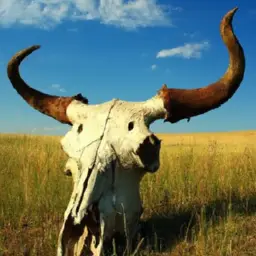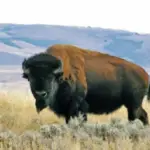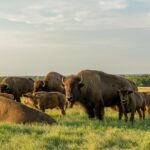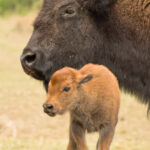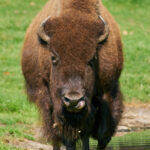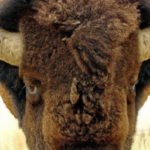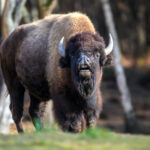Imagine being transported back in time to the year 1800, where vast herds of bison roamed freely across the American plains. Have you ever wondered just how many of these magnificent creatures existed during that era? How Many Bison Were There In 1800 is here to answer that burning question. This fascinating product offers a captivating insight into the historical population of bison during the 19th century, shedding light on the challenges they faced and the lasting impact it had on their numbers. Get ready to embark on a journey of discovery as you uncover the fascinating tale of the bison population in 1800.
Understanding the Importance of the Bison
The historical significance of bison
The bison, also known as the American buffalo, holds immense historical significance in the United States. For centuries, it served as a vital resource for Native American tribes, providing them with food, clothing, and shelter. Additionally, the bison played a crucial role in shaping the culture and spirituality of these tribes, becoming a symbol of strength, abundance, and resilience.
Bison and their influence on Native American culture
The bison’s influence on Native American culture cannot be overstated. Tribes such as the Lakota, Cheyenne, and Blackfeet relied heavily on the buffalo for survival. They viewed the bison with deep respect and incorporated its imagery and symbolism into their rituals, dances, and artwork. The buffalo robe, one of the most valued possessions, represented warmth, protection, and a connection to the natural world.
The bison’s role in the ecosystem
Apart from its cultural importance, the bison also played a vital role in the ecosystem. Being a keystone species, it had a significant impact on the flora and fauna of the Great Plains. As large herbivores, bison shaped the landscape by grazing on grasses and creating open spaces. Their hooves aided in seed dispersal and soil aeration, fostering the growth of diverse plant communities. The presence of bison also influenced the behavior and distribution of other species, including predators and scavengers.
Estimating Bison Populations in the 1800s
Methods of historical population estimation
Estimating the bison population in the 1800s is a complex task, but historians and scientists have utilized various methods to approximate the numbers. These methods include historical accounts and observations, Native American oral traditions, fur traders’ records, and archaeological evidence. While these sources can provide valuable insights, it is important to recognize the limitations and potential biases associated with each method.
Factors complicating bison population estimation
Several factors further complicate the estimation of historical bison populations. The vastness and remote nature of the Great Plains made it difficult to conduct comprehensive surveys. The nomadic lifestyle of Native American tribes and their ability to influence bison movements also posed challenges. Moreover, natural population fluctuations, disease outbreaks, and climatic variations were factors that influenced bison populations and made accurate estimations even more elusive.
Primary sources referencing bison population in 1800
Despite the challenges, historians have relied on primary sources to shed light on the bison population in 1800. Some accounts by explorers, fur traders, and military personnel provide valuable glimpses into the vast herds they encountered. These firsthand descriptions give us a sense of the magnitude and awe-inspiring nature of the bison herds, but they are often subjective and can only offer rough estimates rather than precise figures.
The Great Herds of the Early 19th Century
Descriptions and accounts of early 19th century herds
In the early 19th century, the Great Plains were home to awe-inspiring herds of bison that stretched as far as the eye could see. Various accounts by explorers and settlers vividly describe the sheer magnitude of these herds. The naturalist and painter George Catlin, for example, wrote about witnessing a single herd that took six days to pass a given point. Such descriptions highlight the immense numbers and ecological dominance of the bison during this period.
Geographical range of bison in 1800
The bison’s geographical range in 1800 encompassed a vast expanse of North America. They roamed from present-day Canada down to Mexico and from the eastern slopes of the Rocky Mountains to the Mississippi River. This range covered a significant portion of the Great Plains, which provided a rich and diverse habitat for the bison herds. The adaptability of the bison allowed them to thrive in various environments, from grasslands to forests.
Impact of environment and climate on bison herds
The environment and climate of the Great Plains played a crucial role in shaping the bison herds of the early 19th century. The vast grasslands provided an abundant food source, supporting the growth of large and healthy herds. Additionally, the presence of rivers and water sources ensured that bison had access to essential water throughout the year. The climate of the region, with its extreme temperatures and seasonal variations, also influenced the migratory patterns and behaviors of the herds.
Impact of European Settlement on Bison Populations
European demand for bison products
The arrival of European settlers in North America had a profound impact on bison populations. The demand for bison products, such as hides, meat, and bones, skyrocketed as the settlers sought to exploit the vast resources of the continent. Bison hides, in particular, were highly valued for their durability and served as a major trade commodity, leading to widespread hunting and commercialization of the species.
Disease transmission from European livestock
With European settlers came their domesticated livestock, which inadvertently introduced diseases to the bison populations. Domestic cattle carried pathogens such as bovine tuberculosis and brucellosis, which proved devastating to the bison herds. The bison, not having developed resistance to these diseases, succumbed to large-scale illness and mortality, further decimating their numbers.
Habitat loss due to expanding settlements
As European settlements expanded across North America, the bison’s habitat faced relentless encroachment. The conversion of grasslands into farmland and the construction of railroads led to the fragmentation and destruction of bison ranges. The loss of suitable habitat limited the areas where bison could roam freely, pushing them towards smaller and more vulnerable populations. This loss of habitat remains one of the key factors contributing to the decline of the bison population.
The Bison Population Collapse in the Late 19th Century
Increasing hunting pressures
With the increasing demand for bison products and the rise of commercial hunting, the population of bison faced intense pressure. The introduction of more efficient firearms and the expansion of the fur trade led to indiscriminate and systematic hunting of bison. This unregulated and unsustainable hunting resulted in a rapid decline in their numbers, pushing them to the brink of extinction.
Government policies encouraging bison extermination
In a devastating turn of events, the United States government actively promoted the extermination of the bison population. As a means to subdue Native American tribes and force them onto reservations, the government implemented policies that aimed to eliminate the bison herds, a vital resource for these tribes. This deliberate effort led to the decimation of bison populations and, tragically, the destruction of a cultural and ecological icon of the American West.
Surviving bison populations at the turn of the century
By the late 19th century, the bison population had reached a critically low point. However, a few small herds managed to survive, primarily due to their isolation in remote areas or the efforts of a handful of individuals who recognized the importance of preserving the species. These surviving bison populations formed the foundation for the eventual recovery and conservation initiatives that would take place in the 20th century.
Conservation Efforts in the 20th Century
Founding of national parks and reserves for bison
Recognizing the dire need for conservation measures, efforts were undertaken in the 20th century to protect and restore bison populations. The establishment of national parks and reserves, such as Yellowstone National Park and Wind Cave National Park, provided safe havens for bison herds to thrive under protection, free from the pressures of hunting and habitat loss. These protected areas played a pivotal role in safeguarding the bison and initiating their recovery.
Breeding and reintroduction programs
To bolster the bison populations, breeding and reintroduction programs were implemented. These programs aimed to breed bison in captivity and reintroduce them to suitable habitats. Through careful management and monitoring, these initiatives have successfully enhanced the genetic diversity and ensured the viability of bison populations in various regions, contributing to their long-term survival.
Legislation for bison protection and recovery
Legislation has played a vital role in the protection and recovery of bison populations. Acts such as the Bison Conservation Act of 2000 and the National Bison Legacy Act of 2016 have emphasized the importance of preserving bison as a cultural and ecological heritage. These laws have provided additional legal protection and supported conservation efforts across federal, state, and tribal lands.
The Current Status of the Bison
Estimated current bison populations
After teetering on the brink of extinction, the bison population has shown signs of recovery. Today, the estimated number of bison in North America is approximately 400,000. While this is a significant improvement from the population collapse of the late 19th century, it is still a fraction of the historical numbers. Continued conservation efforts are necessary to ensure the long-term survival and restoration of bison populations.
Threats facing today’s bison
Though the bison population has made strides towards recovery, they still face several threats to their existence. Habitat loss due to agriculture, urbanization, and energy development remains a significant concern. Fragmentation of populations, genetic concerns, and the potential transmission of diseases from domestic livestock pose additional challenges. Climate change and its adverse effects on food availability and ecosystem dynamics further exacerbate the risks faced by the bison.
Bison as a species of conservation concern
Given the continued threats and challenges facing the bison, they are recognized as a species of conservation concern. Efforts to protect their habitat, manage populations, and mitigate the risks they face are ongoing. The status of the bison as a culturally and ecologically significant species highlights the importance of continued conservation and the need to integrate their preservation into broader landscape and biodiversity management strategies.
Relevance of Historical Bison Population Estimates
Influence on current conservation strategies
Historical bison population estimates provide important context and guidance for current conservation strategies. Understanding the scale and grandeur of the bison herds of the past helps conservationists comprehend the magnitude of the loss and the urgency of protecting the remaining populations. By referencing historical estimates, conservationists can set realistic population goals, monitor trends, and implement appropriate measures to safeguard the species.
Role in understanding ecosystem changes
Studying historical bison populations also aids in understanding ecosystem changes and the cascading effects of their decline. As a keystone species, the bison’s interactions with the environment had profound effects on the Great Plains ecosystem. Analyzing historical population estimates alongside ecological data allows scientists to explore the impacts of the bison’s absence on vegetation dynamics, soil health, wildlife distribution, and other ecosystem processes.
Importance for cultural and historical preservation
Beyond their ecological significance, historical bison population estimates hold immense importance for cultural and historical preservation. By acknowledging the vast herds that once roamed the plains, we honor the heritage and resilience of Native American tribes who depended on the bison for their physical and spiritual sustenance. Historical estimates provide a tangible link to the past and remind us of the need for cultural appreciation and understanding in our conservation efforts.
Fascinating Bison Facts
Key characteristics of bison
Bison, belonging to the Bovidae family, are the largest land mammals in North America. They possess distinctive physical characteristics, including a massive head with a hump, shaggy fur, and a large shoulder hump. Male bison, known as bulls, can weigh up to 2,000 pounds and stand over six feet tall at the shoulder. Females, called cows, are slightly smaller, weighing around 900 to 1,100 pounds.
Bison behavior and lifestyle
Bison exhibit unique behaviors and social structures. They form social groups known as herds, typically composed of females and their offspring. Mature bulls, on the other hand, tend to be solitary or form small bachelor groups. Bison engage in various behaviors such as wallowing in dust or mud, which helps them regulate body temperature and remove parasites. During mating season, known as the rut, bulls engage in intense displays of aggression and dominance.
Bison and their adaptability to different environments
Bison demonstrate remarkable adaptability to diverse environments. They can thrive in a range of habitats, including grasslands, shrublands, forests, and even semi-arid regions. Their ability to withstand harsh weather conditions, such as extreme temperatures and heavy snow, allows them to survive in various climates. This adaptability has been a key factor in their historical distribution across North America and their continued presence today.
How has the population of wild bison changed since 1800?
The wild bison population estimate has drastically plummeted since 1800, with millions of these majestic creatures being wiped out due to hunting, habitat loss, and disease. Once ranging in the tens of millions, their numbers now hover in the thousands, making conservation efforts crucial for their survival.
Lessons Learnt from Bison Population Change
Reflection on human-wildlife relationships
The dramatic population decline of the bison serves as a stark reminder of the complex relationship between humans and wildlife. The overhunting and deliberate efforts to exterminate the bison demonstrate the potential consequences of exploiting natural resources without proper consideration for sustainability and ecological balance. It prompts us to reflect on the ethics and responsibilities associated with our interactions with wildlife and the need for conservation-minded practices.
Illustration of consequences of overhunting
The collapse of the bison population showcases the far-reaching consequences of overhunting and the depletion of keystone species. The loss of the bison herds had cascading effects on the Great Plains ecosystem, leading to changes in vegetation, soil dynamics, and impacts on other wildlife species. This serves as a powerful illustration of the interconnectedness of ecosystems and highlights the importance of preserving key species to maintain ecological integrity.
Role in shaping conservation efforts
The story of the bison population change has played a central role in shaping contemporary conservation efforts. It has served as a catalyst for the establishment of protected areas, the implementation of breeding programs, and the development of legislation to safeguard endangered species. The bison’s history reminds us of the urgency to protect biodiversity, restore habitats, and engage in responsible stewardship of our natural resources.
In conclusion, the bison holds immense historical, cultural, and ecological importance. The vast herds that once roamed North America, their decline, and subsequent conservation efforts provide valuable lessons for us to learn. By understanding the impact of human actions on wildlife populations and the importance of preserving key species, we can strive to create a future where the bison continues to thrive and inspire generations to come.

